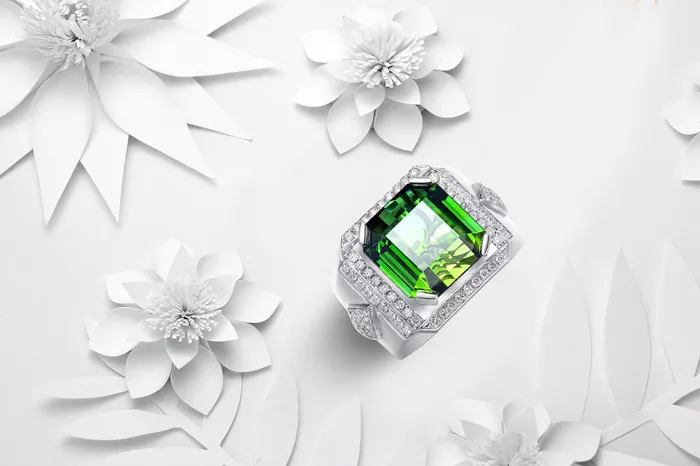Tourmaline, known for its wide range of colors, is a gemstone that captivates the hearts of many. Among the various hues, transparent pink tourmaline holds a special place, blending elegance and charm. However, identifying genuine pink tourmaline can be challenging due to the presence of counterfeit gems. This article aims to provide a detailed introduction to the methods for identifying transparent pink tourmaline from a professional jewelry appraiser’s perspective.
Hardness Test
One of the fundamental methods for identifying pink tourmaline is through a hardness test. Tourmaline ranks 7 on the Mohs Scale of Hardness, which means it is relatively hard and durable. To conduct this test, find a discreet spot on the gemstone and gently rub a steel knife blade (typically ranking 5.5 on the Mohs Scale) against it. If the blade scratches the stone, it suggests that you are dealing with a fake gemstone that is softer than genuine pink tourmaline. This simple yet effective test can help eliminate softer imitations such as glass or plastic.
Color Change Under Artificial Light
Genuine tourmalines often exhibit a unique color-changing property under artificial light. While most tourmalines change color to some degree, pink tourmalines may display a brownish undertone when exposed to bright artificial light. If your stone does not show this undertone, it may be a fake. However, it’s worth noting that rubellites, a vibrant, reddish pink variety of tourmaline, do not change color under artificial light. Therefore, it’s crucial to consider the specific color variety when performing this test.
Inclusions and Clarity
Examining the stone closely for inclusions can also provide valuable clues. Inclusions are small scratches, fractures, or other imperfections within the gemstone. These are commonly found in natural pink tourmalines and serve as a sign of authenticity. If your tourmaline is flawless and looks too perfect to be true, it’s probable that you are dealing with a synthetic or treated gemstone. Remember, natural gems often have unique imperfections that add to their charm.
Professional Jewelry Appraisal
When in doubt, consulting a professional jeweler is always a wise choice. Jewelers have access to powerful microscopes and specialized tools that can help detect even the smallest signs of tampering or synthesis. They can perform a thorough examination of the gemstone, analyzing its physical properties, chemical composition, and any internal structures that may indicate its authenticity. A professional appraisal not only confirms the gem’s authenticity but also provides insights into its quality, rarity, and potential value.
Chemical Composition and Species Identification
Tourmaline’s chemical composition plays a crucial role in determining its physical properties and color. Tourmalines belong to a group of closely related mineral species that share the same crystal structure but have different chemical compositions. These species include elbaite, liddicoatite, dravite, uvite, and schorl. Each species can exhibit a range of colors, and understanding these species can help narrow down the possibilities when identifying a pink tourmaline.
For example, chrome tourmaline is known for its intense green color, caused primarily by vanadium. While it’s not typically pink, understanding this chemical composition can help appreciate the complexity of tourmaline’s coloration. Similarly, rubellite, the trade name for pink, red, or reddish-purple tourmalines, has its own distinct chemical characteristics that set it apart from other tourmaline species.
Trade Names and Color Varieties
The world of tourmaline is rich with trade names that reflect the stone’s diverse color palette. Rubellite, as mentioned earlier, is the term used for pink and reddish varieties. Indicolite refers to dark violetish blue, blue, or greenish blue tourmalines, while Paraíba tourmalines are known for their intense violetish blue, greenish blue, or blue hues, often with flashes of green caused by copper.
Parti-colored tourmalines, as their name suggests, display more than one color. These gems can be a striking combination of green and pink, among other possibilities. Watermelon tourmalines are another unique variety, featuring a pink center surrounded by green. These color combinations add to the appeal and rarity of certain tourmaline specimens.
Cat’s-Eye Effect
Some tourmalines exhibit a cat’s-eye effect, called chatoyancy. This phenomenon is caused by numerous thin, tube-like inclusions that form naturally during the gem’s growth. Cat’s-eye tourmalines are most often green, blue, or pink, with an eye that’s softer and more diffused than that of fine cat’s-eye chrysoberyl. To observe this effect, the stone must be cut as a cabochon, allowing the light to interact with the inclusions and create the striking cat’s-eye appearance.
Origin and Mining
The origin of the tourmaline can also provide insights into its authenticity. Tourmalines are found worldwide, with notable deposits in Brazil, Africa, and other locations. Understanding the geological and mining contexts of these deposits can help appraisers assess the likelihood of a gemstone’s authenticity. For example, Paraíba tourmalines, first discovered in the 1980s, are primarily sourced from the state of Paraíba, Brazil, and are known for their unique color and rarity.
Synthetic and Treated Tourmalines
While natural tourmalines are beautiful and valuable, synthetic and treated gems also exist. Synthetic tourmalines are created in laboratories, often mimicking the physical and chemical properties of natural gems. Treated tourmalines, on the other hand, undergo processes to enhance their color or clarity.
Identifying synthetic or treated tourmalines requires a combination of tests and expertise. Gemologists look for signs of artificial intervention, such as unusual color distribution, lack of natural inclusions, or inconsistent hardness. Advanced analytical techniques, such as spectroscopy and X-ray diffraction, can further confirm the authenticity and treatment history of a gemstone.
Conclusion
Identifying transparent pink tourmaline involves a combination of physical tests, chemical analysis, and professional expertise. By understanding the gemstone’s hardness, color-changing properties, inclusions, chemical composition, and species, appraisers can accurately assess its authenticity and quality. Consulting a professional jeweler and utilizing specialized tools and techniques can provide additional peace of mind and ensure that you are investing in a genuine and valuable gemstone.
Related topic:
- Black Tourmaline: Can It Be Polished?
- How Is Black Tourmaline Formed?
- Black Tourmaline and Its Connection to Chakras


